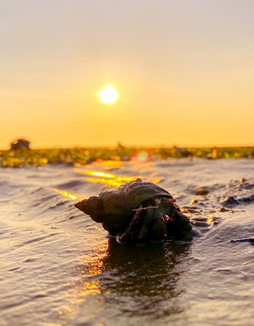With the generous assistance from Ellie Parker, Marine Officer for Solent Seagrass Restoration Work at the Trust, I embarked on my dissertation titled ‘A Critical Evaluation and Stakeholder Perceptions of Seagrass Meadows at Calshot and Chilling, Hampshire, Southern England’.
The main goal of my dissertation was to evaluate the effectiveness of the seagrass restoration and monitoring at Calshot and monitoring at Chilling that is underway as part of the Solent Seascape Project. I also spoke to some key stakeholders involved with seagrass in the Solent, including Blue Marine Foundation, Project Seagrass, a local resident, the Trust, and a Solent Seagrass Champion Volunteer. I started with a site recce at Calshot on a chilly May morning, before the crack of dawn. It was beautiful to see the uncovered seagrass meadow with the glowing sunrise behind it. Other than the citizen science volunteers, there was no one around (not including the scurrying hermit crabs) making it a very peaceful morning.



